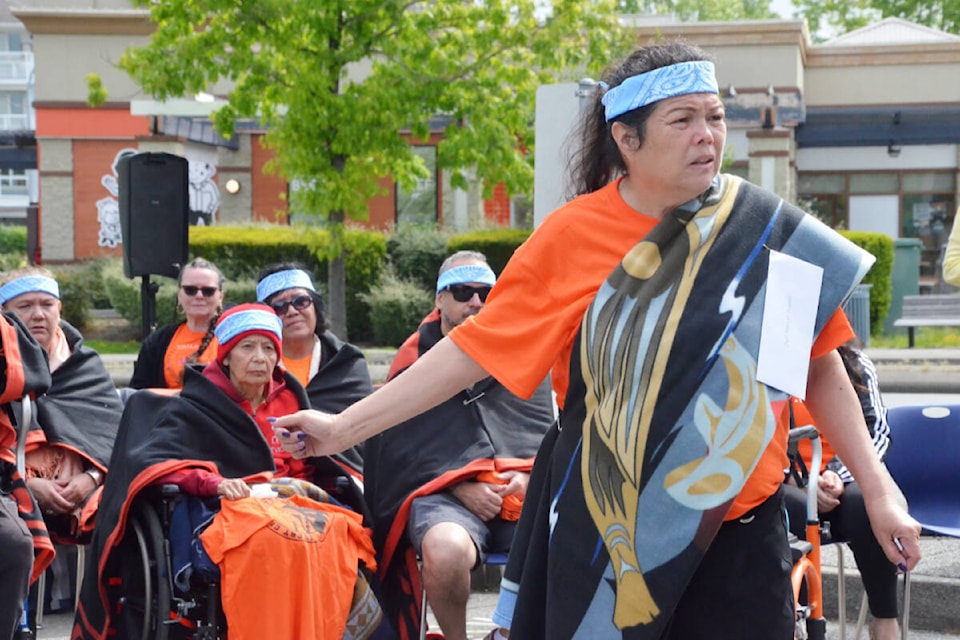A court proceeding which began in a Vancouver courthouse on Thursday, Jan. 18 may end a long-running dispute over the leadership of the Kwantlen First Nation.
The currently recognized hereditary leadership of the KFN brought the court action to counter a dissident group. The dissidents have been pushing for reform and calling for the chief to step down, and held a meeting in the fall of 2022 where they appointed three of their own councillors.
Kwantlen First Nation has for the past several decades been one of the few large Indigenous nations in B.C. governed entirely by a hereditary chief and an appointed band council. Chief Marilyn Gabriel is the second chief under the most recent version of the system, which was put in place by her father. She has been chief since 1993.
A majority of First Nations across the country have some form of elected leadership, but a significant number are what the federal government refers to as “custom” or “customary” governance. That can include a variety of forms of leadership, including some forms of hereditary rule.
The current push for change began officially in 2019, when a group of KFN members, dissatisfied with the current leadership, demanded Marilyn Gabriel resign as chief. Third-party mediation began shortly after that, but did not resolve the issues, and the chief did not step down.
On Nov. 27, 2022, a different hereditary chief, Robert Thomas, called an assembly of KFN members, and a vote selected three new councillors: Brandon Gabriel, Christopher Thomas, and Victor Back. Brandon Gabriel is Chief Marilyn Gabriel’s nephew – many people on both sides of the dispute are related.
This left Kwantlen with two sets of leaders – a hereditary leadership recognized by federal authorities in Ottawa, and three assembly councillors who were not.
The hereditary KFN government asked for the judicial review, and one outcome they want is for the court to order that the dissidents stop claiming they are official councillors.
As for the band members supporting the assembly councillors, they want the KFN to create a new governance code, similar to a constitution, to set out exactly how KFN should be governed.
On Thursday morning, after a traditional song by KFN members, Federal Court Justice Peter Pamel asked whether the two sides had been able to come to some kind of resolution or compromise since the date was set for the hearing.
“There hasn’t been movement towards resolution or reconciliation, justice, between the two sides,” said Tim Dickson, the lawyer representing the hereditary chief and council. “The issues remain as entrenched as they were in October I would say, potentially more.”
Lawyer Evan Duffy, for the dissident group, said unfortunately that was true.
“I do think we’re here for determination of the issues on this,” Duffy said.
The two lawyers set out the broad strokes of their arguments, which would rely on legal precedent, history, and traditional law and leadership customs among the Kwantlen people and other Sto:lo nations of the Fraser Valley.
Much of the case will turn on how the Kwantlen community as a whole can change its leadership or governance structure.
Both sides entered the hearing acknowledging that while there can be hereditary governance in Kwantlen First Nation, there was also a means for the Kwantlen people to change that, or even to remove chiefs.
“There’s no dispute that it [governance] may be changed if there’s a broad consensus among community members,” Pamel said.
The legal fight centers around whether the Nov. 27, 2022 assembly could count as “broad consensus.” Dickson argued it fell well short of that.
He characterized the Nov. 27 meeting as an “attempted coup.”
READ ALSO:
READ ALSO:
“They [the new assembly councillors] have based their claims to authority on it since,” Dickson said. “So there is a great deal of importance on sorting that issue out, as to whether that meeting actually does give them that authority or not.”
Dickson said he would argue that there was overwhelming evidence against the idea that the assembly had been broad-based enough.
Duffy argued that it was.
“We say it’s consensus, and we say it has to be looked at contextually, especially when there’s active attempts being made to prevent people from participating,” Duffy said.
“That argument’s being made on both sides, Mr. Duffy,” Pamel said, referring to the attempts to prevent people from taking part.
Another question that the hearing might answer is how to define broad consensus for the future, even if Pamel finds that the assembly did not have the power to usher in any changes.
While Dickson was opposed to a prescriptive approach, Duffy was more open to it, including to the possibility of a vote or referendum.
“My friend [Dickson] says there’s no broad consensus,” Duffy said. “Then a vote would confirm that!”
The early part of the hearing also touched on whether the existing leadership was moving towards reform, as Dickson said they were.
Duffy argued that was not happening, pointing to correspondence between the factions after the Nov. 27 assembly.
“We got nothing,” Duffy said. “We got obfuscation, stonewalling, and litigation.”
He said they had great difficulty accepting that the hereditary chief and leadership were interested in reform.
Pamel warned at the outset of the hearing whatever ruling he makes, it might not be popular.
“I can say that one side is not going to be happy, and most likely both sides are not going to be happy,” he said.
Both sides were making detailed arguments on Thursday, and the hearing was expected to continue into Friday, Jan. 19.



